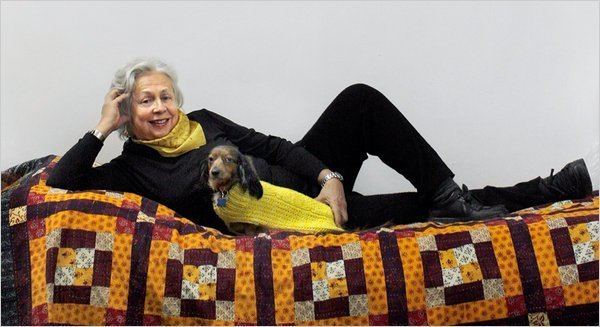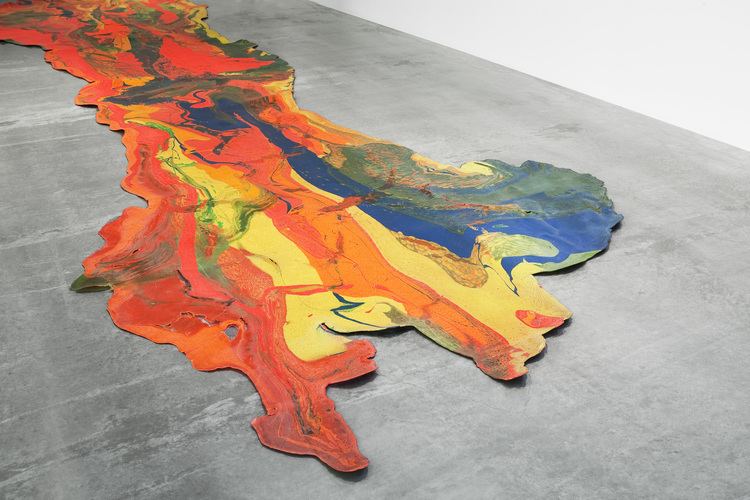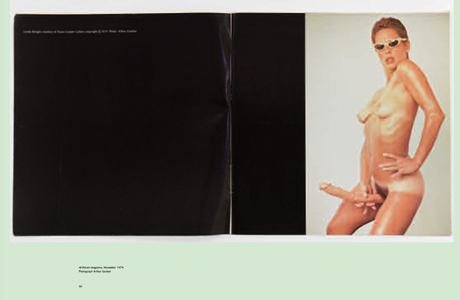Nationality American Name Lynda Benglis | Role Visual Artist Known for Sculpture, Painting | |
 | ||
Education H. Sophie Newcomb Memorial College (1964) Artwork Embryo II, Quartered Meteor, Eat Meat, Come Similar People Louise Bourgeois, Eva Hesse, Robert Morris, Hannah Wilke, Pat Steir | ||
Lynda benglis 2010 retrospective excerpt
Lynda Benglis (born October 25, 1941) is an American sculptor and visual artist known especially for her wax paintings and poured latex sculptures. She currently lives between New York City; Santa Fe; Kastelorizo, Greece; and Ahmedabad, India.
Contents
- Lynda benglis 2010 retrospective excerpt
- Lynda benglis discusses adhesive products
- Early life
- Career
- History
- Theory
- Reception and criticism
- 2009 Irish Museum of Modern Art IMMA Retrospective
- 2011 Show at the New Museum
- 2012 Thomas Dane Gallery in London
- Collaborations
- Video work
- Exhibitions
- Recognition
- References

Lynda benglis discusses adhesive products
Early life

Benglis was born in Lake Charles, Louisiana on October 25, 1941. She is Greek-American. Growing up her father Michael ran a building-materials business. Her mother was from Mississippi and was a preacher's daughter. She is the eldest of five children. Benglis attended McNeese State University in Lake Charles, Louisiana. She earned a BFA in 1964 from Newcomb College in New Orleans, which was then the women's college of Tulane University, where she studied ceramics and painting. Following graduation, she taught third grade at Jefferson Parish, in Louisiana. In 1964 Benglis moved to New York. Here she came in contact with many of the influential artists of the decade, such as Andy Warhol, Donald Judd, Sol LeWitt, Eva Hesse, and Barnett Newman. She went on to study painting at the Brooklyn Museum Art School. There she met the Scottish painter Gordon Hart, who was briefly to be her first husband. Benglis later stated that she married Hart to help him avoid the draft. She also took a job as an assistant to Klaus Kertess at the Bykert Gallery before moving on to work at the Paula Cooper Gallery. In 1979 she met her life partner, Anand Sarabhai, on a trip to Ahmedabad, India. Sarabhai died in February 2013.
Career

Benglis's work is noted for an unusual blend of organic imagery and confrontation with newer media incorporating influences such as Barnett Newman and Andy Warhol. Her early work used materials such as beeswax before moving on to large polyurethane pieces in the 1970s and later to gold-leaf, zinc, and aluminum. The validity of much of her work was questioned until the 1980s due to its use of sensuality and physicality.

Like other artists such as Yves Klein, Benglis mimicked Jackson Pollock's flinging and dripping methods of painting. Works such as Fallen Painting (1968) inform the approach with a feminist perspective. For this work, Benglis smeared Day-Glo paint across the gallery floor invoking "the depravity of the 'fallen' woman" or, from a feminist perspective, a "prone victim of phallic male desire". These brightly colored organic floor pieces were intended to disrupt the male-dominated minimalism movement with their suggestiveness and openness.

Like other female artists, she was attracted by the newness of a medium that was uncorrupted by male artists. The structure of the new medium itself played an important role in addressing questions about female identity in relation to art, pop culture, and dominant feminism movements at the time.

Benglis has been a professor or visiting artist at the University of Rochester (1970-1972), Princeton University (1975), University of Arizona (1982), School of Visual Arts (1985-1987).
History
Benglis felt underrepresented in the male-run artistic community and so confronted the "male ethos" in a series of magazine advertisements satirizing pin-up girls, Hollywood actresses, and traditional depictions of nude female models in canonical works of art. Benglis chose the medium of magazine advertisements as it allowed her complete control of an image rather than allowing it to be run through critical commentary. This series culminated with a particularly controversial one in the November 1974 issue of Artforum featuring Benglis aggressively posed with a large latex dildo and wearing only a pair of sunglasses promoting an upcoming exhibition of hers at the Paula Cooper Gallery. Benglis paid $3,000 for the Artforum ad. One of her original ideas for the advertisement had been for her and collaborative partner Robert Morris to work together as a double pin-up, but eventually found that using a double dildo was sufficient as she found it to be "both male and female". Morris, too, put out an advertisement for his work in that month's Artforum which featured himself in full "butch" S&M regalia.
Theory
In this unmaking of the tradition of the passive female nude, Benglis was working in dialogue with popular discourse about gender and gender performativity published at the time of its execution. In particular, Benglis appears to be undermining June Wayne's theory of the "demonic myth" in which males, in assuming their gender identity, are responsible to a similar posturing and performativity as women, but instead of upholding "feminine" values of passivity, modesty, and gentility, they embody a guise of compensatory hyper-masculinity and heroic bravado. By adopting a phallus, Benglis physically and symbolically muddies the distinction made between these two types of gender performativity and ultimately overturns them, resulting in a positive assertion of femininity's sexual and cultural power.
Reception and criticism
Although Benglis's image is now popularly cited as an important example of gender performativity in contemporary art, it provoked mixed responses when it first appeared. Artist Barbara Wagner claims that Benglis shows that even with the appropriation of the phallus as a Freudian sign of power, it does not cover her female identity and still emphasizes a female inferiority. Rosalind Krauss and other Artforum personnel attacked Benglis's work in the following month's issue of Artforum describing the advertisement as "exploitative" and "brutalizing". Critic Cindy Nemser of The Feminist Art Journal dismissed the advertisement as well, claiming that the picture showed that Benglis had "so little confidence in her art that she had to resort to kinky cheesecake to push herself over the top." Morris's advertisement, however, generated little commentary, providing evidence for Benglis's view that male artists were encouraged to promote themselves, whereas women were chastised for doing so. Benglis eventually cast five lead sculptures of the dildo that she posed with on the Artforum cover, each entitled Smile, one for each of the Artforum editors who wrote in to complain about her ad.
2009 Irish Museum of Modern Art (IMMA) Retrospective
Benglis’s work was greatly neglected for a long time. However, in 2009, a 40-year retrospective organized by the Irish Museum of Modern Art served to recognize her career. The exhibit showed her in her true light as a main figure in contemporary art. Not only did it show her vast amount of her work, it showed her enthusiasm to take on charged subjects. The exhibition focused on the 1960s and 1970s, when her work was most involved with the link between painting and sculpture. It included the lozenge-shaped wall pieces of built up multicolored wax layers that Benglis started making in 1966 with which she honored Jackson Pollock's famous drip methods. It also included her knotted bowtie shaped wall reliefs of the 1970s and some of her videos. Her work from the 1980s and 1990s was also shown, represented by a few of her famous pleats, which involved her spraying liquid metal onto chicken wire skeletons, and two videos from each of the decades.
In the stateside versions of the show more works from the 1980s and 1990s were shown including her ceramics. These pieces were made of clay and hand molded so that the viewers could feel the making of them- the extorting, folding, and throwing of the moist resistant material. Glazes seemed to be flung on in a causal manner, which brings to mind the abstract expressionism movement of art in which Benglis is involved. The ceramic pieces have a handmade quality that effect the senses both desire driven and dismal, while the colors suggest the glitz of commercial culture.
Concentrating on Benglis’s early work, the curators gave her a main position in the diverse art of the 70’s, a time period that is seen as laying the groundwork for the wide range of expression that continues to grow to this day. Benglis’s willingness and ability to mix up gendered tropes with her heroic scales and sparkly colorful finishes while laughing irreverently at views of every moral stripe set her apart from the common customs of feminism and the sexism of the art world. Her work is also deemed important for its meticulous grounding in process and materials used. Each piece produces its own physical understanding. “They provoke visceral reactions while playfully welcoming open ended associations and ambiguities.”
2011 Show at the New Museum
In 2011, The New Museum organized a four-decade exhibition of Benglis's sculptural works with supplementary videos, Polaroids, and magazine clippings. The show received high praise in the New Yorker magazine, which warned viewers to "prepare to be floored."
2012 Thomas Dane Gallery in London
This subsequent survey focused on the exploratory breadth of materials Benglis experimented with over the course of her career: polyurethane foam, glass, enamel, stainless steel, beeswax, and poured latex. It was her first major survey in the UK.
Collaborations
Benglis created a series of prints as part of a collaboration with master printer Stan Baden with the Print Research Institute of North Texas at the University of North Texas.
Video work
During the 1970s, Benglis engaged in dialogues relating to the feminist movement through her art by pioneering a radical body of video work made up of fifteen videos. Benglis' performance-based videos confront issues of gender and identity by referencing the societal representation and construction of women and their sexuality as well as the interaction between viewer and artist, self and ambiguity. Though Benglis' sculptures reference sexuality through subtly eroticized materials and forms, her video work approaches the subject conceptually and more explicitly.
Benglis’s interest in human form found in her sculptural work is made present in her videos in through the consistent theme of self-reflexivity. Benglis employs various technical manipulations of video as a medium to complicate the boundaries of visual form and highlight mediations of the self. By doing so, she further exposes the interface between inner and outer realities by using and reproducing her own body and its image through video manipulations. Consequently, Benglis’s work destabilizes what are traditionally believed to be video’s “inherent properties” such as liveness and “real” time, spatial orientation and relations, and separation of creator and creation.
In 1971, Benglis began to collaborate with Robert Morris, creating Benglis's video Mumble (1972) and Morris's Exchange (1973). One of her own more noted videos is Female Sensibility (1973), which shows the artist kissing and licking the face of fellow artist Marilyn Lenkowsky. Many other of Benglis's earlier solo films are highly technically manipulated, edited, and re-taped, thus blending present and past video sequences and selves to enhance the feeling of artifice. For instance, in Now (1972) (12 min, color, sound) the artist superimposes a video of herself yelling commands such as "Now!" and "Start recording!" over an older video of herself, blurring the line between documentary and performance while also making it difficult to tell which image of the artist is present, which is past, and which of these is therefore truly performing.
In Noise (1972) (7 min, B&W, sound) Benglis employs mechanical reproduction and through looped feedback tapes. Throughout Noise, she plays over several generations of similar taped images and soundtracks to introduce increasing amounts of distortion. The conversion of the looped and layered aural and visual components highlights the boundaries of intelligibility, resulting in the disassociation of sound and image. In On Screen (1972) (7 min, B&W, sound) Benglis visually implicates infinite regression of time and space, similarly manipulating generations of videotapes to confound the viewer’s sense of time. The sequence of creation, presented as a gendered self-portrait, is heavily obscured by the layered repetition of aural and visual components. Through this exercise of audiovisual desynchronization, the notions of "original self” and “original production” are complicated by the layers of self-images presented simultaneously with layers of "self". In doing so, Benglis emphasizes that video as a medium is based upon mechanical reproduction, thus subverting the classical notion of authenticity and reproduction in fine art.
Exhibitions
On November 4, 2009, Benglis’s first European retrospective opened at the Irish Museum of Modern Art, in Dublin, where it ran through January 24, 2010. It then moved to Le Consortium, in Dijon, France; the Museum of Art at the Rhode Island School of Design, in Providence; and the New Museum, in New York.
Between 1969 and 1995 Benglis held over 75 solo exhibitions of her work both in the United States and abroad. Benglis's work is held in collections including The Guggenheim, the Los Angeles County Museum of Art, the Scottsdale Museum of Contemporary Art, the High Museum, Albright-Knox Art Gallery, New Orleans Museum of Art, the San Francisco Museum of Modern Art, Museum of Modern Art, Corcoran Gallery of Art, Whitney Museum of American Art, the Walker Art Center, Hokkaido Museum of Modern Art, National Gallery of Victoria and others.
Recognition
In 1975 Benglis was awarded with a Guggenheim Fellowship. She has also received two grants from the National Endowment for the Arts, one in 1979 and the other in 1990.
In 2000 Benglis was awarded an honorary doctorate from the Kansas City Art Institute.
Benglis has been awarded a Minos Beach Art Symposium grant, a grant from the Delphi Art Symposium, a grant from the Olympiad of Art Sculpture Park (Korea), all in 1988. Benglis received a grant from the National Council of Art Administration in 1989.
Benglis won a Yale-Norfolk Summer School Scholarship in 1963, and a Max Beckman scholarship in 1975.
